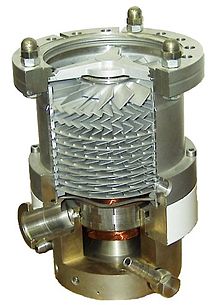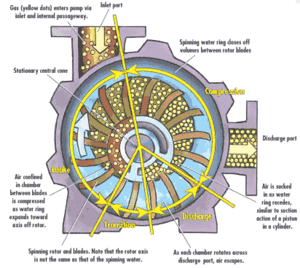Vacuum Pumps
Vacuum Pump is a device that removes gas molecules from a sealed volume in order to leave behind a partial vacuum. The first vacuum pump was invented in 1650 by Otto von Guericke, and was preceded by the suction pump, which dates to antiquity.
Types
Pumps can be broadly categorized according to three techniques:
- Positive displacement pumps use a mechanism to repeatedly expand a cavity, allow gases to flow in from the chamber, seal off the cavity, and exhaust it to the atmosphere.
- Momentum transfer pumps, also called molecular pumps, use high speed jets of dense fluid or high speed rotating blades to knock gas molecules out of the chamber.
- Entrapment pumps capture gases in a solid or adsorbed state. This includes cryopumps, getters, and ion pumps.
Positive Displacement Pumps are the most effective for low vacuums. Momentum transfer pumps in conjunction with one or two positive displacement pumps are the most common configuration used to achieve high vacuums. In this configuration the positive displacement pump serves two purposes. First it obtains a rough vacuum in the vessel being evacuated before the momentum transfer pump can be used to obtain the high vacuum, as momentum transfer pumps cannot start pumping at atmospheric pressures. Second the positive displacement pump backs up the momentum transfer pump by evacuating to low vacuum the accumulation of displaced molecules in the high vacuum pump. Entrapment pumps can be added to reach ultrahigh vacuums, but they require periodic regeneration of the surfaces that trap air molecules or ions. Due to this requirement their available operational time can be unacceptably short in low and high vacuums, thus limiting their use to ultrahigh vacuums. Pumps also differ in details like manufacturing tolerances, sealing material, pressure, flow, admission or no admission of oil vapor, service intervals, reliability, tolerance to dust, tolerance to chemicals, tolerance to liquids and vibration.
Performance measures
- Pumping speed refers to the volume flow rate of a pump at its inlet, often measured in volume per unit of time. Momentum transfer and entrapment pumps are more effective on some gases than others, so the pumping rate can be different for each of the gases being pumped, and the average volume flow rate of the pump will vary depending on the chemical composition of the gases remaining in the chamber.
- Throughput refers to the pumping speed multiplied by the gas pressure at the inlet, and is measured in units of pressure·volume or unit time. At a constant temperature, throughput is proportional to the number of molecules being pumped per unit time, and therefore to the mass flow rate of the pump. When discussing a leak in the system or backstreaming through the pump, throughput refers to the volume leak rate multiplied by the pressure at the vacuum side of the leak, so the leak throughput can be compared to the pump throughput.
Positive displacement and momentum transfer pumps have a constant volume flow rate , but as the chamber's pressure drops, this volume contains less and less mass. So although the pumping speed remains constant, the throughput and mass flow rate drop exponentially. Meanwhile, the leakage, evaporation, sublimation and backstreaming rates continue to produce a constant throughput into the system.
Techniques
Vacuum pumps are combined with chambers and operational procedures into a wide variety of vacuum systems. Sometimes more than one pump will be used in a single application. A partial vacuum, or rough vacuum, can be created using a positive displacement pump that transports a gas load from an inlet port to an outlet port. Because of their mechanical limitations, such pumps can only achieve a low vacuum. To achieve a higher vacuum, other techniques must then be used, typically in series . Some examples might be use of an oil sealed rotary vane pump backing a diffusion pump, or a dry scroll pump backing a turbomolecular pump. There are other combinations depending on the level of vacuum being sought.
Achieving high vacuum is difficult because all of the materials exposed to the vacuum must be carefully evaluated for their outgassing and vapor pressure properties. For example, oils, and greases, and rubber, or plastic gaskets used as seals for the vacuum chamber must not boil off when exposed to the vacuum, or the gases they produce would prevent the creation of the desired degree of vacuum. Often, all of the surfaces exposed to the vacuum must be baked at high temperature to drive off adsorbed gases. Outgassing can also be reduced simply by desiccation prior to vacuum pumping. High vacuum systems generally require metal chambers with metal gasket seals such as Klein Flanges or ISO flanges, rather than the rubber gaskets more common in low vacuum chamber seals. The system must be clean and free of organic matter to minimize outgassing. All materials, solid or liquid, have a small vapour pressure, and their outgassing becomes important when the vacuum pressure falls below this vapour pressure. As a result, many materials that work well in low vacuums, such as epoxy, will become a source of outgassing at higher vacuums. With these standard precautions, vacuums of 1 mPa are easily achieved with an assortment of molecular pumps. With careful design and operation, 1 µPa is possible. Several types of pumps may be used in sequence or in parallel. In a typical pumpdown sequence, a positive displacement pump would be used to remove most of the gas from a chamber, starting from atmosphere to 25 Torr . Then a sorption pump would be used to bring the pressure down to 10−4 Torr . A cryopump or turbomolecular pump would be used to bring the pressure further down to 10−8 Torr . An additional ion pump can be started below 10−6 Torr to remove gases which are not adequately handled by a cryopump or turbo pump, such as helium or hydrogen.
Ultra high vacuum generally requires custom-built equipment, strict operational procedures, and a fair amount of trial-and-error. Ultra-high vacuum systems are usually made of stainless steel with metal-gasketed Conflat flanges. The system is usually baked, preferably under vacuum, to temporarily raise the vapour pressure of all outgassing materials in the system and boil them off. If necessary, this outgassing of the system can also be performed at room temperature, but this takes much more time. Once the bulk of the outgassing materials are boiled off and evacuated, the system may be cooled to lower vapour pressures to minimize residual outgassing during actual operation. Some systems are cooled well below room temperature by liquid nitrogen to shut down residual outgassing and simultaneously cryopump the system.
In ultra-high vacuum systems, some very odd leakage paths and outgassing sources must be considered. The water absorption of aluminium and palladium becomes an unacceptable source of outgassing, and even the absorptivity of hard metals such as stainless steel or titanium must be considered. Some oils and greases will boil off in extreme vacuums. The porosity of the metallic chamber walls may have to be considered, and the grain direction of the metallic flanges should be parallel to the flange face.
The impact of molecular size must be considered. Smaller molecules can leak in more easily and are more easily absorbed by certain materials, and molecular pumps are less effective at pumping gases with lower molecular weights. A system may be able to evacuate nitrogen to the desired vacuum, but the chamber could still be full of residual atmospheric hydrogen and helium. Vessels lined with a highly gas-permeable material such as palladium create special outgassing problems.
Uses of vacuum pumps
Vacuum pumps are used in many industrial and scientific processes including:
- Composite Plastic moulding processes
- Driving some of the flight instruments in older and simpler aircraft without electrical systems.
- The production of most types of electric lamps, vacuum tubes, and CRTs where the device is either left evacuated or re-filled with a specific gas or gas mixture
- Semiconductor processing, notably ion implantation, dry etch and PVD, ALD, PECVD and CVD deposition and soon in photolithography
- Electron microscopy
- Medical processes that require suction
- Uranium enrichment
- Medical applications such as radiotherapy, radiosurgery and radiopharmacy
- Analytical instrumentation to analyse gas, liquid, solid, surface and bio materials
- Mass spectrometers to create an ultra high vacuum between the ion source and the detector
- Vacuum coating on glass, metal and plastics for decoration, for durability and for energy saving, such as low-emissivity glass
- Hard coating for engine components
- Ophthalmic coating
- Milking machines and other equipment in dairy sheds
- Air conditioning service - removing all contaminants from the system before charging with refrigerant
- Trash compactor
- Vacuum engineering
- Sewage systems
- Freeze drying
- Fusion research
Vacuum may be used to power, or provide assistance to mechanical devices. In diesel engined motor vehicles, a pump fitted on the engine is used to produce vacuum. In petrol engines, instead, vacuum is obtained as a side-effect of the operation of the engine and the flow restriction created by the throttle plate. This vacuum may then be used to power:
- The vacuum servo booster for the hydraulic brakes
- Motors that move dampers in the ventilation system
- The throttle driver in the cruise control servomechanism
In an aircraft, the vacuum source is often used to power gyroscopes in the various flight instruments. To prevent the complete loss of instrumentation in the event of an electrical failure, the instrument panel is deliberately designed with certain instruments powered by electricity and other instruments powered by the vacuum source.

